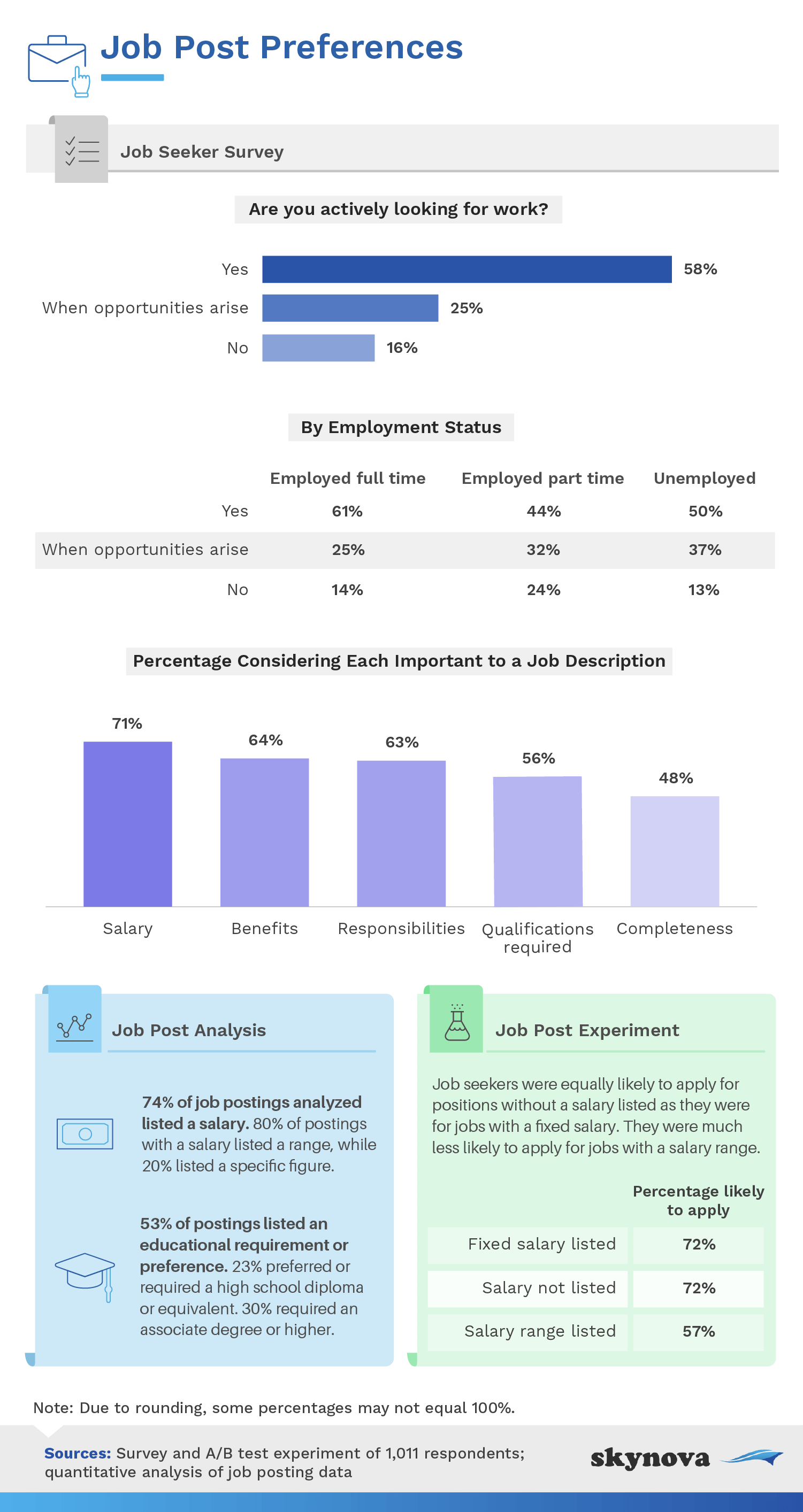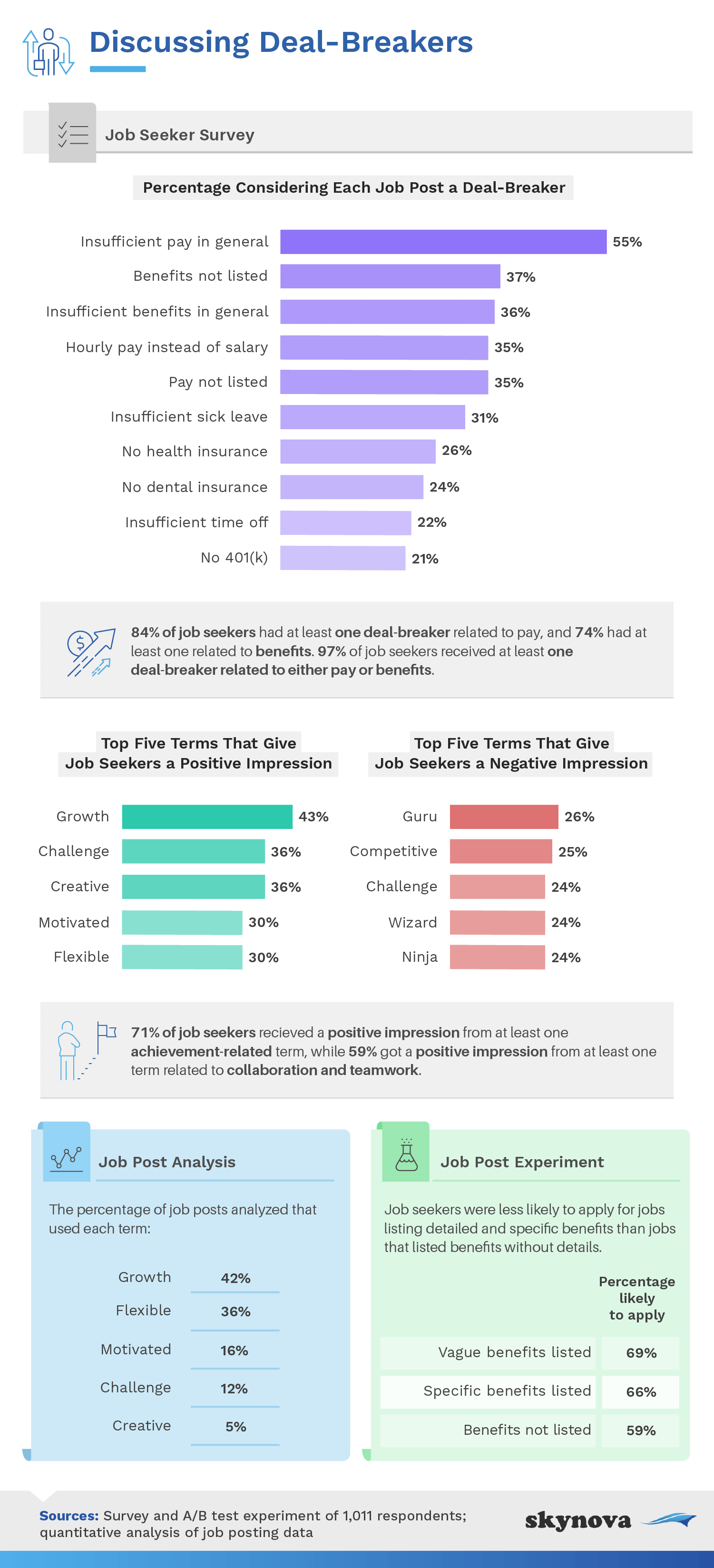
|
Our analysis reveals the most (and least) effective job post practices.
When employers advertise an open position, many find that the job post faces similar competition to that which job seekers encounter while searching for their ideal role.
According to the Bureau of Labor Statistics, 4.3 million Americans gave their notice in August 2021 alone. This is symptomatic of an ongoing labor shortage that may make potential job seekers feel more empowered to scrutinize postings and be more selective about their next position than ever before. Some may look to specific words and phrases to understand duties and expectations for the role. Salary, benefits, and job duties are obvious factors for prospective employees. At the same time, certain words and phrases may turn some people away.
To gain an in-depth understanding of what type of job postings attract applicants, we surveyed over 1,000 respondents, ran an A/B test experiment regarding different job post styles, and performed a bulk analysis of real job postings. For the A/B test experiment, also known as a split test, we showed alternative versions of the same job posts to different groups of respondents to compare sentiment toward certain job post characteristics. For our bulk analysis, we examined the contents of over 180 recent postings from a diverse range of job types.
Whether you’re hoping to advance your career or looking to recruit for your own business, take a few moments to find out what the data shows about today’s job market.
Many people are actively seeking a job. Others are just exploring what opportunities are available. Are salary and benefits the factors that drive job hunters the most?

Of those in our survey, 58% classified themselves as active job seekers, while another 25% tended to explore job listings just to see what’s out there.
It’s easy to assume that all unemployed people are actively seeking work. Surprisingly, only 50% fell into this category. Another 37% said they might become motivated when the right opportunity arises, while 13% of out-of-work individuals weren’t looking for a job at all.
Some people are always looking for greener pastures—such as the 61% of employed respondents who said they were actively seeking better opportunities. Only 44% of part-time workers said they were actively searching for a job, while 24% of the same group were not looking for any position at all.
An intriguing statistic of this study is the impact of salary on job postings. For example, some jobs may list a salary or compensation range, while similar ads don’t mention any salary level. Does the absence of a specified salary deter potential applicants? Our respondents said it doesn’t.
When presented with two similar job postings—one with a salary listed and one without—the same number of respondents (72%) said they were likely to apply. Although 20% of job postings mentioning a salary provided a specific salary figure, 80% provided a range—giving both employer and potential employee some room for negotiation. Overall, 74% of job postings mentioned a salary or wage.
Most employers that post open jobs aspire to attract a pool of talented applicants. However, some phrases or job descriptions turned our respondents away.

Have you ever worked for a company with a guru? You know, the super go-getter who accomplishes every task with blazing speed and never makes a mistake. In reality, these co-workers rarely, if ever, exist. Plus, over a quarter of respondents said using the word "guru" left a negative impression.
Speaking of words that left a poor taste in the mouth, "competitive," "ninja," "challenge," and "wizard" didn’t fare much better. Words that left a positive impression included "growth" at 43%, followed by "flexible" and "motivated."
In our analysis of job postings, we found that over 40% of employers used "growth," while 36% incorporated "flexible." However, only 16% asked for "motivated" individuals, and just 5% referenced an applicant’s "creative" abilities.
In terms of job post deal-breakers, it’s no surprise that insufficient pay was a massive turnoff for 55% of respondents. In addition to hard dollars, benefits were another significant factor. Job seekers may discount a position entirely if the company fails to include information about prominent benefits, such as health coverage, vacation and sick days, or child care options.
One statistic that stood out from our A/B test was that job seekers were slightly more likely to apply for positions with vague benefit descriptions as opposed to posts with a detailed list of benefits. Moreover, almost 60% would still apply even if a posting didn’t mention benefits at all.
Simply put, words and how they are used in job postings matter. More often than not, applicants are attracted to job postings that paint a detailed picture of their responsibilities and duties.

There’s a good chance some job seekers have encountered job descriptions that, after reading, left them with no clue as to what the role’s specific responsibilities actually were. Sixteen percent of respondents said they rarely come across job descriptions that accurately describe the position or paint a clear picture of what it involves. Meanwhile, 31% said they are typically confused by job postings.
On a more positive note, 53% said they typically see words and phrases that make positions seem appealing. Nevertheless, posters should be careful to avoid using too much company jargon—something that 38% of respondents said is typical of the posts they read.
Employers obviously seek experienced job applicants, yet only 53% of analyzed job postings mentioned educational requirements or preferences, with 30% requiring an associate degree or higher. Twenty-three percent were willing to consider applicants with a high school diploma or equivalent; however, 52% of respondents believed that most job descriptions ask too much from applicants.
Three-quarters of job descriptions analyzed incorporated the word "experience," while 59% used "skills." Other words hitting or exceeding the 50% mark were "manage" and "customer." Descriptive terms used less often in job postings included "operate," "environment," and "develop."
In previous years, working remotely or from home was an option for very few employees. Since the COVID-19 pandemic, however, there’s no question that an increasing number of workers perform tasks remotely. Exactly two-thirds of analyzed job descriptions mentioned whether remote work was offered; but only 8% expressly listed this way of working as an option. Will future applicants push companies to provide more remote possibilities, or will companies mandate that applicants work in the office or on job sites?
An unhappy employee can lead to a pretty lackluster work environment, while a happy and motivated employee can take any workplace to the next level. With high numbers of job seekers out there looking for the right new employer, it’s important they are able to find it among the plethora of potentially confusing or insufficiently outlined postings. Of the most important specifics to include in job postings, many respondents indicated that salary was the most important aspect, followed by the benefits package. Terms like "growth" created a positive impression among job seekers when used in a job posting, meanwhile terms like "guru" and "competitive" proved to generate negative attention. Overall, it’s important that job postings are specific and professional to attract the right, specific talent employers want on their team.
Skynova provides online software for small businesses to help them invoice, track time, and manage their accounting. In addition, we like to write in-depth articles about various topics we, and hopefully our customers, find interesting. Our articles generally have a business or workplace angle and often intersect with another area of society. They are based on surveys, statistics, and research we conduct ourselves.
For this analysis, we relied on three distinct forms of analysis. We surveyed 1,011 respondents about their preferences and experiences with job postings and ran an experiment with those same respondents. For our experiment, respondents were presented with different versions of a job posting and asked to rate it on various characteristics. We also gathered 180 postings from a diverse range of job types and performed an analysis of that data.
Among our respondents, 612 were men, 398 were women, and one identified as nonbinary. Our respondents ranged in age from 18 to 75 years old with an average age of 38.
In some cases, questions and answers have been rephrased for clarity or brevity. To help guarantee accurate responses, all respondents were required to answer an attention-check question. Some of these data rely on self-reporting, and potential issues with self-reported data include, but are not limited to, selective memory, telescoping, and other attribution errors.
If you feel your readers could benefit from the job posting information in this article, please share it with them. We only ask that you credit us by linking back to this piece and that you distribute it for noncommercial uses only.